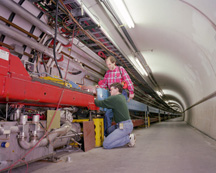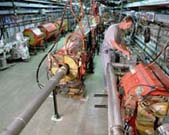Inquiring Minds
|
Physics at Fermilab main page | accelerators | collider experiments | neutrino physics | technology computing | theory | astrophysics | discoveries at Fermilab |
|
|
|
|
Details about Fermilab's accelerators To create the world's most powerful particle beams, Fermilab uses a series of accelerators. The diagram and photos show the paths taken by protons and antiprotons.
The third stage, the Booster, is located about 20 feet below ground. The Booster is a circular accelerator that uses magnets to bend the beam of protons in a circular path. The protons travel around the Booster about 20,000 times so that they repeatedly experience electric fields. With each revolution the protons pick up more energy, leaving the Booster with 8 billion electron volts (8 GeV).
Inside the Main Injector tunnel, physicists have also installed an Antiproton Recycler (green ring). It stores antiprotons that return from a trip through the Tevatron, waiting to be re-injected.
The Tevatron receives 150 GeV protons and antiprotons from the Main Injector and accelerates them to almost 1000 GeV, or one tera electron volt (1 TeV). Traveling only 200 miles per hour slower than the speed of light, the protons and antiprotons circle the Tevatron in opposite directions. The beams cross each other at the centers of the 5000-ton CDF and DZero detectors located inside the Tevatron tunnel, creating bursts of new particles.
To produce antiprotons, the Main Injector sends 120 GeV protons to the Antiproton Source, where the protons collide with a nickel target. The collisions produce a wide range of secondary particles including many antiprotons. The antiprotons are collected, focused and then stored in the Accumulator ring. When a sufficient number of antiprotons has been produced, they are sent to the Main Injector for acceleration and injection into the Tevatron.
Latest news on Fermilab's accelerators
Educational video on the unit of energy called "electron volt" (4 min.)
|
| last modified 1/15/2002 email Fermilab |
FRLsDFx9eyfrPXgV



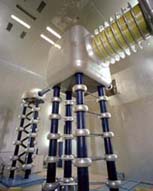 The Cockcroft-Walton pre-accelerator provides the first stage of acceleration. Inside this device, hydrogen gas is ionized to create negative ions, each consisting of two electrons and one proton. The ions are accelerated by a positive voltage and reach an energy of 750,000 electron volts (750 keV). This is about 30 times the energy of the electron beam in a television's picture tube.
The Cockcroft-Walton pre-accelerator provides the first stage of acceleration. Inside this device, hydrogen gas is ionized to create negative ions, each consisting of two electrons and one proton. The ions are accelerated by a positive voltage and reach an energy of 750,000 electron volts (750 keV). This is about 30 times the energy of the electron beam in a television's picture tube.
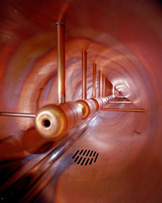 Next, the negative hydrogen ions enter a linear accelerator, approximately 500 feet long. Oscillating electric fields accelerate the negative hydrogen ions to 400 million electron volts (400 MeV). Before entering the third stage, the ions pass through a carbon foil, which removes the electrons, leaving only the positively charged protons.
Next, the negative hydrogen ions enter a linear accelerator, approximately 500 feet long. Oscillating electric fields accelerate the negative hydrogen ions to 400 million electron volts (400 MeV). Before entering the third stage, the ions pass through a carbon foil, which removes the electrons, leaving only the positively charged protons.
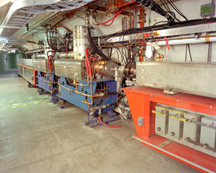
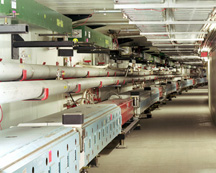 The Main Injector, completed in 1999, accelerates particles and transfers beams. It has four functions: (1) It accelerates protons from 8 GeV to 150 GeV. (2) It produces 120 GeV protons, which are used for antiproton production (see picture and text at bottom). (3) It receives antiprotons from the Antiproton Source and increases their energy to 150 GeV. (4) It injects protons and antiprotons into the Tevatron.
The Main Injector, completed in 1999, accelerates particles and transfers beams. It has four functions: (1) It accelerates protons from 8 GeV to 150 GeV. (2) It produces 120 GeV protons, which are used for antiproton production (see picture and text at bottom). (3) It receives antiprotons from the Antiproton Source and increases their energy to 150 GeV. (4) It injects protons and antiprotons into the Tevatron.
